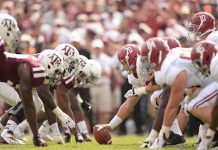COLUMBUS, Ohio (AP) Earle Bruce embraced the difficult task of following his mentor, Woody Hayes, as Ohio State’s head football coach. In his later years, he became a much-loved patriarch of the program he helped build.
Bruce died in Columbus at the age of 87, according to a statement released by his daughters through Ohio State on Friday. He’d been suffering from Alzheimer’s disease.
Bruce had a record of 81-26-1 as head coach at Ohio State from 1979-87. He took over under most unusual and challenging circumstances, hired after the revered Hayes was fired for punching a Clemson player in the 1978 Gator Bowl. Bruce could not meet Hayes’ lofty standards and was never quite embraced by Buckeyes fans the way Hayes was, but even after being fired and moving on to other jobs, he never lost his passion for Ohio State football.
As head coach in 1986 and ’87, Bruce mentored a young graduate assistant on his staff named Urban Meyer, who would go on win a national champion for the school in 2014.
”I’ve made it clear many times that, other than my father, Coach Bruce was the most influential man in my life,” Meyer said in a statement. ”Every significant decision I’ve made growing up in this profession was with him involved in it. His wife (Jean) and he were the role models for Shelley and me. They did everything with class. He was not afraid to show how much he loved his family and cared for his family.”
Born in Pittsburgh and raised in Cumberland, Maryland, Bruce had come to Ohio State in the fall of 1949 to play football. He sustained a knee injury that effectively ended his playing days and got him to thinking about becoming a coach.
He served as an assistant high school coach in Mansfield, and then became a head coach in 1956 at Salem where his teams went 28-9. He moved on to Sandusky High School in 1960 and in four years had a record of 34-3-3 and then took over at mighty Massillon, one of the most renowned prep jobs in the country. In two seasons, Bruce went 20-0.
Hayes beckoned and Bruce joined him as an assistant at Ohio State in 1966. Bruce was in charge of a bruising offensive line that paved the way for the Buckeyes to win three Big Ten titles, two Rose Bowls, go 43-14 and win the 1968 national championship. Bruce was on the 1968 staff that also Lou Holtz Bill Mallory, Lou McCullough and George Chaump. Earlier, Bruce had worked on an Ohio State staff that included Bo Schembechler, who would become the head coach at Michigan and serve as a nemesis for both Hayes and Bruce.
After six years on Hayes’ staff, Bruce became a college head coach for the first time when he spent a year at the University of Tampa and went 10-2 with a colorful cast that included NFL star John Matuszak and George Orendorf, who would go on to become a professional wrestling mainstay.
After a stint at Iowa State, Bruce was hired in January 1979 to replace his mentor and friend. He tackled the job with characteristic energy and organization, despite some criticism from fans who constantly compared him to the sainted Hayes, who had been the Buckeyes’ coach for 28 seasons.
”You don’t want to lose in Columbus, Ohio,” Bruce once told The Associated Press. ”A football loss? That’s terrible. You want to win all your home games. You’re only as good as your last game here.”
After winning or sharing four Big Ten titles, he was fired in 1987 after falling into disfavor with Ohio State President Ed Jennings.
He went on to do stints as head coach at Northern Iowa and Colorado State before returning to Columbus in retirement and again becoming an integral part of Buckeyes football. He worked for years as a radio analyst on Ohio State football and was well known for saying how he ”bled scarlet and gray.”
He was inducted into the College Football Hall of Fame in 2003.
Bruce was preceded in death by his wife, Jean. Survivors include four daughters, nine grandchildren – including Ohio State wide receivers coach Zach Smith – and three great grandchildren.
25% Bonus via Western Union

















